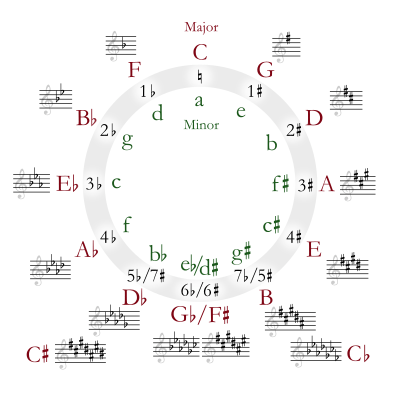Minor scale facts for kids
A minor scale in music is a series of notes that often sounds a bit sad or serious. Imagine a happy song; it probably uses a major scale. A minor scale gives music a different, often more thoughtful or dramatic feel.
There are three main types of minor scales that musicians use a lot in Western music: the natural minor, the harmonic minor, and the melodic minor. Each one has a slightly different sound because of how its notes are arranged.
Contents
What is a Natural Minor Scale?
The natural minor scale is the simplest type. It's like taking a major scale and starting it from a different note. For example, if you play all the white keys on a piano from C to C, you get a C major scale. If you start from A (the sixth note of the C major scale) and play all the white keys up to the next A, you get an A natural minor scale!
This A natural minor scale is called the "relative minor" of C major because they share the same notes, just starting from a different place.
Understanding Harmonic and Melodic Minor Scales
Musicians sometimes change the natural minor scale to create different sounds. This leads to the harmonic and melodic minor scales.
The Harmonic Minor Scale
The harmonic minor scale is almost the same as the natural minor, but with one important change: the seventh note is raised by a semitone (which is the smallest step between two notes, like from a white key to the black key right next to it on a piano).
For example, in the A natural minor scale, the notes are A, B, C, D, E, F, G, A. In the A harmonic minor scale, the G note is raised to G♯ (G sharp). So, the notes become: A, B, C, D, E, F, G♯, A.
This change creates a unique sound, especially between the sixth and seventh notes (like F and G♯ in A minor). This gap is a bit bigger than usual, which gives the harmonic minor scale its special, sometimes dramatic, sound. It's often used in music from the Middle East.
The Melodic Minor Scale
Some composers found the jump in the harmonic minor scale a bit tricky for smooth melodies. So, they came up with the melodic minor scale, which changes depending on whether you are playing the notes going up or down.
When you play the melodic minor scale going up (ascending), both the sixth and seventh notes are raised. For example, in A melodic minor ascending, the notes are A, B, C, D, E, F♯, G♯, A. This makes it sound brighter when going up.
However, when you play the melodic minor scale going down (descending), it's exactly the same as the natural minor scale. So, for A melodic minor descending, the notes are A, G, F, E, D, C, B, A. This makes it sound softer when going down.
Musicians often choose which minor scale to use based on the feeling they want to create in their music. Sometimes, they even mix notes from different minor scales in one song!
Finding Key Signatures
Every major scale has a "relative minor" scale that shares the same key signature. A key signature tells you which notes are sharp or flat in a piece of music.
To find the relative minor of a major key, you just go down three half-steps (or a minor third) from the major key's starting note. For example, C major has no sharps or flats in its key signature. If you go down three half-steps from C, you land on A. So, A minor is the relative minor of C major, and it also has no sharps or flats in its key signature.
If G major has one sharp in its key signature, then its relative minor, E minor, also has one sharp.
Sometimes, different keys can sound the same but be written differently. For example, B major and C♭ major (C flat major) sound the same on a piano, but they have different key signatures. These are called "enharmonic" scales.
| Key Sig. | Major Scale | Minor Scale | ||
|---|---|---|---|---|
| 5♯/7♭ | B/C♭ major | g♯/a♭ minor | ||
| 6♯/6♭ | F♯/G♭ major | d♯/e♭ minor | ||
| 7♯/5♭ | C♯/D♭ major | a♯/b♭ minor |
Other pages





